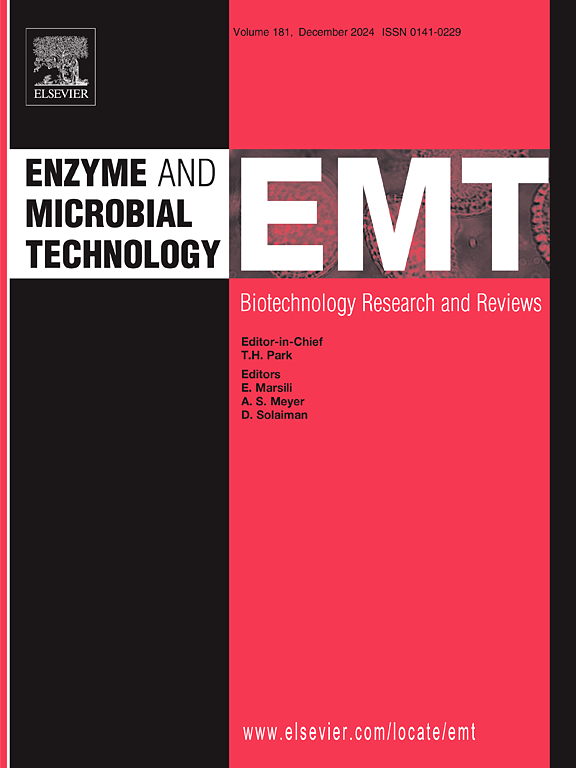On-site cellulase production by Trichoderma reesei RutC-30 to enhance the enzymatic saccharification of ball-milled corn stover
IF 3.4
3区 生物学
Q2 BIOTECHNOLOGY & APPLIED MICROBIOLOGY
引用次数: 0
Abstract
Cellulases are essential for the enzymatic saccharification of lignocellulose. They play a crucial role in breaking down the structure of lignocellulose to obtain fermentable sugars. In this study, we conducted on-site cellulase production by Trichoderma reesei RutC-30 through submerged fermentation. The effects of carbon source, nitrogen source, KH2PO4, and mineral elements on cellulase production were evaluated using the hydrolyzed total sugar concentration of ball-milled corn stover as an indicator. The optimal fermentation medium conditions for cellulase production were determined through orthogonal experimental design analysis. Additionally, by optimizing culture conditions, including inoculation, pH, and bottling volume, we achieved a total sugar concentration of 92.25 g/L. After the optimization, the FPA, CMCA, protein, and total sugar concentration increased by 75.49 %, 18.43 %, 89.71 %, and 17.83 %, respectively. Furthermore, corn stover pretreated by different methods was applied to induce cellulase production. Ball-milled and steam-exploded corn stover was identified as suitable incubation carbon sources with total sugar concentration up to 94.31 g/L. Our work exploits the cellulase induced by lignocellulose and then applies it to lignocellulose, enabling the customization and providing a reference for the production of cellulase with corn stover as an inducer.
利用毛霉 RutC-30 现场生产纤维素酶,提高球磨玉米秸秆的酶糖化效果。
纤维素酶对木质纤维素的酶促糖化至关重要。它们在分解木质纤维素结构以获得可发酵糖类方面发挥着至关重要的作用。在本研究中,我们通过浸没发酵法利用毛霉 RutC-30 现场生产纤维素酶。以球磨玉米秸秆的水解总糖浓度为指标,评估了碳源、氮源、KH2PO4 和矿物质元素对纤维素酶生产的影响。通过正交实验设计分析,确定了纤维素酶生产的最佳发酵培养基条件。此外,通过优化接种、pH 值和装瓶量等培养条件,我们获得了 92.25 克/升的总糖浓度。优化后,FPA、CMCA、蛋白质和总糖浓度分别提高了 75.49 %、18.43 %、89.71 % 和 17.83 %。此外,玉米秸秆经不同方法预处理后可诱导纤维素酶的产生。球磨玉米秸秆和蒸汽爆破玉米秸秆被确定为合适的培养碳源,总糖浓度高达 94.31 克/升。我们的工作利用了木质纤维素诱导的纤维素酶,然后将其应用于木质纤维素,实现了定制化,为以玉米秸秆为诱导剂生产纤维素酶提供了参考。
本文章由计算机程序翻译,如有差异,请以英文原文为准。
求助全文
约1分钟内获得全文
求助全文
来源期刊

Enzyme and Microbial Technology
生物-生物工程与应用微生物
CiteScore
7.60
自引率
5.90%
发文量
142
审稿时长
38 days
期刊介绍:
Enzyme and Microbial Technology is an international, peer-reviewed journal publishing original research and reviews, of biotechnological significance and novelty, on basic and applied aspects of the science and technology of processes involving the use of enzymes, micro-organisms, animal cells and plant cells.
We especially encourage submissions on:
Biocatalysis and the use of Directed Evolution in Synthetic Biology and Biotechnology
Biotechnological Production of New Bioactive Molecules, Biomaterials, Biopharmaceuticals, and Biofuels
New Imaging Techniques and Biosensors, especially as applicable to Healthcare and Systems Biology
New Biotechnological Approaches in Genomics, Proteomics and Metabolomics
Metabolic Engineering, Biomolecular Engineering and Nanobiotechnology
Manuscripts which report isolation, purification, immobilization or utilization of organisms or enzymes which are already well-described in the literature are not suitable for publication in EMT, unless their primary purpose is to report significant new findings or approaches which are of broad biotechnological importance. Similarly, manuscripts which report optimization studies on well-established processes are inappropriate. EMT does not accept papers dealing with mathematical modeling unless they report significant, new experimental data.
 求助内容:
求助内容: 应助结果提醒方式:
应助结果提醒方式:


